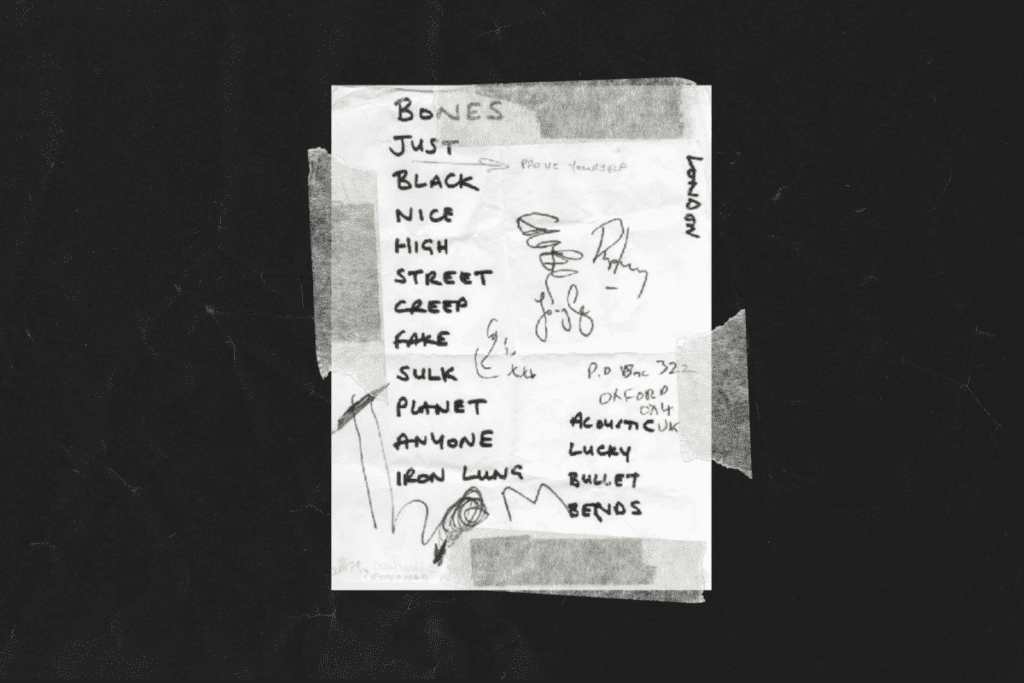Live performances play a vital role in the success of many musicians and bands and are often a crucial part of their careers. The energy and connection created between artists and audiences during a live show is truly special. One of the critical components of a successful live performance is a well-planned setlist. But how do bands and musicians create their setlists?
There are different approaches that musicians can take when creating their setlists, including chronological order, mood and energy level, song popularity, musical theme or concept, audience interaction, and special occasions or events. Refining a setlist can involve practicing and rehearsing, getting feedback from band members and others, making adjustments based on audience response, and incorporating new songs over time.
Setlists are crucial because they help artists manage their time on stage, connect with the audience, and create cohesive and memorable performances. Factors to consider when crafting a setlist include the genre of music and audience expectations, the size and type of venue, time constraints, flow and pacing of the show, key changes, and technical considerations.
In this article, we’ll dive into the factors that musicians consider when crafting their setlists, the different approaches they can take, and the tips for refining their setlists over time. By the end of this comprehensive guide, you’ll have a better understanding of how bands create their setlists and how you can apply these strategies to your own performances.

FACTORS TO CONSIDER WHEN CREATING A SETLIST
When crafting a setlist, there are several factors that musicians must consider. These factors will help to create a setlist that not only suits their style of music but will also connect with their audience and create a memorable performance.
AUDIENCE EXPECTATIONS
One of the most important factors to consider is the genre of music and audience expectations. For instance, if a band is playing a pop show, they may want to stick to their most popular tracks to keep the audience engaged. On the other hand, if the genre is rock, they may want to focus on heavier tracks with a faster tempo.
VENUE SIZE & TYPE
The venue size and type are also crucial factors to consider. The size of the venue can influence the type of songs that should be played, with larger venues requiring more energy and crowd-pleasing tracks. In smaller venues, musicians have more freedom to experiment with different sounds and styles.
Playing the right size venue is an important part of booking the right shows for your band. Check out our guide to Showcasing Your Sound: How To Book Live Shows & Build A Following.
TIME CONSTRAINTS
Time constraints are another factor to keep in mind when creating a setlist. Many venues have strict time limits, and it’s essential to ensure that the setlist doesn’t run over the allocated time. Musicians can use software or apps to time their set and ensure that they stick to the schedule.
FLOW & PACING
The flow and pacing of the show are also important factors. A well-planned setlist should take the audience on a journey, with high-energy tracks interspersed with slower, more emotive songs. Musicians must also consider the transitions between songs, ensuring that they are seamless and do not interrupt the flow of the performance.
TECHNICAL CONSIDERATIONS
Key changes and technical considerations are also vital factors that musicians must take into account. For instance, they may need to consider the tuning of their instruments and any equipment changes required between songs. They must also consider any key changes between songs to ensure that they flow smoothly.
In summary, creating a setlist requires careful consideration of several factors. Musicians must take into account the genre of music, audience expectations, venue size and type, time constraints, flow and pacing of the show, key changes, and technical considerations. By considering these factors, musicians can craft a setlist that engages and excites their audience, creating an unforgettable performance.

APPROACHES TO CREATING A SETLIST
When creating a setlist, musicians have several approaches they can take. These approaches can help them craft a setlist that engages their audience, creates a memorable performance, and showcases their unique style.
CHRONOLOGICAL ORDER
One approach is to follow a chronological order. This means that the setlist will follow the order in which the songs were released. This approach can be useful for bands that have been around for a long time and have an extensive back catalog. Following a chronological order can be a great way to take the audience on a journey through the band’s history and showcase the evolution of their sound.
MOOD & ENERGY
Another approach is to focus on the mood and energy level of the performance. This means that the setlist will be carefully crafted to create a particular mood or atmosphere. For instance, if the band is going for an upbeat and energetic performance, they may start with high-energy tracks and build up to a climax towards the end of the show.
Having a clear image of your band can help craft the mood and energy of a performance. Check out our guide to Creating A Band Image: How To Develop Your Look & Sound.
SONG POPULARITY
Song popularity is another factor that musicians can consider when creating a setlist. They can prioritize their most popular tracks to keep the audience engaged and singing along. This approach can be especially effective for local bands or bands with a super supportive fanbase.
Many famous musicians prioritize their most popular tracks in their setlists, including Taylor Swift, Coldplay, Beyoncé, Ed Sheeran, and Guns N’ Roses. By incorporating their biggest hits (or not) into their live performances, these artists engage their audiences and create memorable experiences.
MUSICAL THEME OR CONCEPT
A musical theme or concept is another approach that can help musicians create a cohesive and memorable performance. They can build a setlist around a particular theme, such as love or heartbreak, or a particular concept, such as storytelling or nostalgia. This approach can help to create a more emotional connection with the audience and showcase the band’s unique style.
AUDIENCE INTERACTION
Audience interaction is another important approach to consider when creating a setlist. This means that the setlist will be designed to get the audience involved and create a more interactive performance. Musicians can include crowd favorites that the audience can sing along to or even ask the audience to request songs.
SPECIAL OCCASIONS
Finally, special occasions or events can also influence the setlist. For example, if the band is performing at a festival, they may want to tailor their setlist to fit the theme of the festival or the time of day they are performing.
There are several approaches that musicians can take when creating a setlist. They can follow a chronological order, focus on mood and energy level, prioritize song popularity, build a setlist around a musical theme or concept, incorporate audience interaction, or tailor the setlist to fit special occasions or events. By experimenting with different approaches, musicians can create a setlist that engages their audience and showcases their unique style.

TIPS FOR REFINING A SETLIST
Refining a setlist is an essential part of creating a successful live performance. By making tweaks and adjustments, musicians can create a setlist that resonates with their audience and delivers a memorable performance. Here are some tips for refining a setlist:
PRACTICING & REHEARSING
Practicing and rehearsing the setlist is crucial. By practicing the setlist in advance, musicians can ensure that they are confident with the transitions between songs, the flow of the performance, and the timing of the set. Rehearsing the setlist can also help to identify any potential issues, such as songs that don’t work well together, and make the necessary adjustments.
Does your band need somewhere to rehearse? Check out this list of 10 Practice Spaces For Bands That Have Nowhere To Rehearse.
GETTING FEEDBACK FROM OTHERS
Getting feedback from band members and others can also be beneficial. Musicians can ask for feedback from their band members and other industry professionals, such as sound engineers or managers. Getting feedback can help to identify areas for improvement and provide valuable insights into what works well and what doesn’t.
Collaborating with other artists is a great way to get feedback from others. Check out these Essential Benefits of Collaborating with Other Musicians.
MAKING ADJUSTMENTS
Making adjustments based on audience response is another tip for refining a setlist. During a live performance, musicians can observe the audience’s reaction and adjust the setlist accordingly. For instance, if the audience is more responsive to a particular type of song, musicians can adjust the setlist to include more songs that fit that style.
Making adjustments isn’t always easy, though. Morrissey of The Smiths once said, “I would find the idea of compiling a setlist that doesn’t wildly excite me to be too restricting.”
While it’s important to consider audience response, musicians should also stay true to their own style and artistic vision. Finding the right balance between audience engagement and personal expression can help musicians create a setlist that truly resonates with their audience and showcases their unique talents.
INCORPORATING NEW SONGS
Incorporating new songs and changing up the setlist over time is also essential. Musicians should regularly add new songs to their setlist to keep it fresh and exciting for their audience. They can also experiment with different approaches and make changes to the setlist over time to keep it relevant and engaging.
Choosing the songs in your setlist is almost as difficult as naming them! Check out How To Name Your Song: 10 Tips For Creating A Memorable Title (With Examples).
Refining a setlist requires practice, feedback, adjustments, and experimentation. Musicians must be willing to make changes and adapt their setlist based on audience response and feedback from others. By following these tips, musicians can create a setlist that showcases their unique style, engages their audience, and creates a memorable live performance.
CREATING A SETLIST IS A PROCESS
Creating a setlist is a critical part of any live performance. By carefully considering genre, venue, audience, and pacing factors, musicians can craft a setlist that engages and entertains their audience, creates a memorable performance, and showcases their unique style.
In this comprehensive guide, we have explored the various approaches that musicians can take when creating a setlist, including chronological order, mood and energy level, song popularity, musical theme or concept, audience interaction, and special occasions or events. We have also provided tips for refining a setlist, including practicing and rehearsing, getting feedback, making adjustments based on audience response, and incorporating new songs over time.
Ultimately, creating a setlist is a process of experimentation and creativity. Musicians must be willing to try different approaches, make changes, and adapt their setlists based on audience response and feedback. By doing so, they can create a setlist that showcases their unique style and delivers a memorable live performance.
Being able to adapt and evolve can be a difficult part of being an artist. Check out our article on Why Many Artists Struggle: The Link Between Sensitivity, Creativity, & Suffering.
So, whether you’re a seasoned musician or just starting, don’t be afraid to experiment and have fun with your setlists. By taking into account the factors and tips discussed in this guide, you can create a setlist that resonates with your audience and makes your live performances truly unforgettable.
RELATED QUESTIONS
How many songs should be in a setlist?
The number of songs in a setlist can vary depending on several factors, such as the length of the performance and the genre of music. Generally, a setlist can range from 8-15 songs, with an average of 10-12 songs per set.
How long should a setlist be?
The length of a setlist can vary depending on the length of the performance, the genre of music, and other factors. Typically, a setlist can be between 30-90 minutes long.
Should musicians stick to their most popular songs when creating a setlist?
While it’s important to include popular songs in a setlist to keep the audience engaged, musicians should also consider the flow and pacing of the show, as well as their personal preferences and unique style.
How often should musicians change their setlist?
Musicians should regularly update and change their setlist to keep it fresh and exciting for their audience. It’s recommended to change the setlist every few shows or every few months, depending on the frequency of performances.
How can musicians incorporate audience requests into their setlists?
Musicians can ask the audience for song requests and incorporate them into their setlist if possible. They can also prepare a list of potential songs to play as a backup in case the requested song is not possible to play.
For more industry tips and music marketing hacks, check out Ennui Magazine. You can also follow us on Facebook, Twitter, Instagram, Pinterest, and YouTube.
